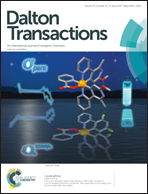Syntheses, structures and electrochemical properties of a class of 1-D double chain polyoxotungstate hybrids [H2dap][Cu(dap)2]0.5[Cu(dap)2(H2O)][Ln(H2O)3(α-GeW11O39)]·3H2O†
Abstract
A series of novel organic–inorganic hybrid 1-D double chain germanotungstates [H2dap][Cu(dap)2]0.5[Cu(dap)2(H2O)][Ln(H2O)3(α-GeW11O39)]·3H2O [Ln = LaIII (1), PrIII (2), NdIII (3), SmIII (4), EuIII (5), TbIII (6), ErIII (7)] (dap = 1,2-diaminopropane) have been hydrothermally prepared and structurally characterized by elemental analyses, powder X-ray diffraction (PXRD), IR spectra, thermogravimetric (TG) analyses, X-ray photoelectron spectroscopy (XPS) and single-crystal X-ray diffraction. The most prominent structural feature of 1–7 is that the [Ln(H2O)3(α-GeW11O39)]5− moieties are firstly connected with each other via the W–O–Ln–O–W bridges creating a 1-D {[Cu(dap)2(H2O)][Ln(H2O)3(α-GeW11O39)]}n3n− polymeric chain and then two adjacent antiparallel 1-D polymeric chains are linked together through [Cu(dap)2]2+ linkages giving rise to the rare organic–inorganic hybrid 1-D CuII–LnIII heterometallic double-chain architectures. To the best of our knowledge, 1–7 represent the first 1-D double-chain CuII–LnIII heterometallic germanotungstates. The variable-temperature magnetic susceptibilities of 2, 4 and 7 have been investigated. Furthermore, the solid-state electrochemical and electro-catalytic properties of 3 and 4 have been measured in 0.5 mol L−1 Na2SO4 + H2SO4 aqueous solution by entrapping them in a carbon paste electrode. 3 and 4 display apparent electro-catalytic activities for nitrite, bromate and hydrogen peroxide reduction.
![Graphical abstract: Syntheses, structures and electrochemical properties of a class of 1-D double chain polyoxotungstate hybrids [H2dap][Cu(dap)2]0.5[Cu(dap)2(H2O)][Ln(H2O)3(α-GeW11O39)]·3H2O](/en/Image/Get?imageInfo.ImageType=GA&imageInfo.ImageIdentifier.ManuscriptID=C3DT53616E&imageInfo.ImageIdentifier.Year=2014)

 Please wait while we load your content...
Please wait while we load your content...